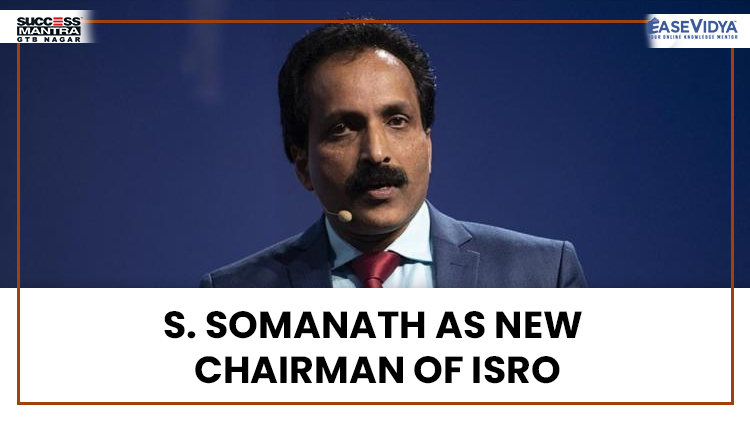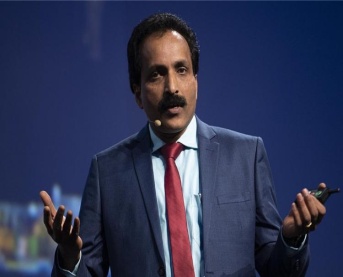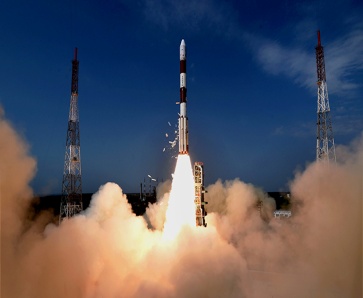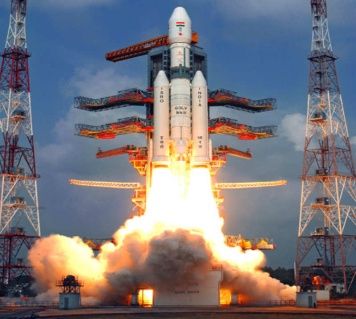
S SOMANATH AS NEW CHAIRMAN OF ISRO
S. SOMANATH AS NEW CHAIRMAN OF ISRO
Eminent rocket scientist S Somanath has been appointed as the chairman of the Indian Space Research Organisation (ISRO) as well as the Space Secretary. Somanath, who is at present Director of Vikram Sarabhai Space Centre (VSSC), will succeed K Sivan who completes his extended tenure. Sivan was in January 2018 appointed as the ISRO chief, Secretary of the Department of Space and Chairman Space Commission. He was in December 2020 given a one-year extension till January 14, 2022. Somanath’s appointment as the Space Secretary and the Space Commission Chairman is for a combined tenure of three years from the date of joining of the post, inclusive of an extension in tenure beyond the age of superannuation in public interest, the order said. The post of the ISRO chairman, the Space Secretary and the Space Commission chief is usually held by one person only. Somanath, who will be the 10th chairman of the premier space organisation, took charge as the VSSC’s head on January 22, 2018, after a two and a half years stint as the Director of Liquid Propulsion Systems Centre (LPSC), Valiamala, Thiruvananthapuram.

Major Contribution of Dr. Somanath
He has played a major role in the development of the Polar Satellite Launch Vehicle (PSLV) and the Geosynchronous Satellite Launch Vehicle Mk-III (GSLV Mk-III). He joined the GSLV Mk-III project in 2003, and served as Project Director from 2010 to 2014. He is an expert in the area of system engineering of launch vehicles. Later on, he contributed to the development of the indigenous cryogenic stages for the GSLV.
ISRO: It is the pioneer space exploration agency of India, headquartered at Bengaluru. ISRO was formed in 1969 with a vision to develop and harness space technology in national development, while pursuing planetary exploration and space science research. ISRO replaced its predecessor, INCOSPAR (Indian National Committee for Space Research), established in 1962 by India’s first Prime Minister Pt. Jawaharlal Nehru and scientist Vikram Sarabhai, considered amongst the founding fathers of the Indian space program.
Current Affairs Notes By Success Mantra Coaching Institute GTB Nagar Delhi CLICK HERE
ACHIEVEMENTS OF ISRO
The first Indian satellite, Aryabhata, was built by the ISRO and launched with the help of the Soviet Union on 19th April 1975. The year 1980 marked the launch of Rohini, which was the first satellite to be successfully placed in orbit by SLV-3, an Indian made launch vehicle.
Subsequently with more efforts, two other rockets were developed by ISRO: the PSLV (Polar Satellite Launch Vehicle) for placing satellites into polar orbits and the GSLV (Geosynchronous Satellite Launch Vehicle) for placing satellites into geostationary orbits. Both the rockets have successfully launched several earth observation and communication satellites for India as well as other countries.

Indigenous satellite navigation systems like IRNSS and GAGAN have also been deployed. Indian Regional Navigation Satellite System is designed to provide accurate position information service to assist in the navigation of ships in the Indian Ocean waters. GAGAN is India's first satellite-based global positioning system that relies on ISRO’s GSAT satellites. In January 2014, ISRO used an indigenously built cryogenic engine for a GSLV-D5 launch of the GSAT-14 satellite making it one of the only six countries in the world to develop a cryogenic technology. Some remarkable space probes of ISRO include Chandrayaan-1 lunar orbiter, Mars Orbiter Mission (Mangalyaan-1) and ASTROSAT space observatory. The success of the Mars Orbiter Mission made India only the fourth country in the world to reach Martian orbit.
India launched Chandrayaan-2, its second lunar exploration mission after Chandrayaan-1 on 22nd July 2019.
MAJOR ISRO ACHIEVEMENTS OF 2021
- Amazonia-1: The 53rd flight of PSLV-C51 marked the first dedicated mission for New Space India Ltd (NSIL), the commercial arm of ISRO. Amazonia-1, the optical earth observation satellite of National Institute for Space Research (INPE), would provide remote sensing data to users for monitoring deforestation in the Amazon region and analysis of diversified agriculture across the Brazilian
- UNITYsat (three satellites): They have been deployed to provide Radio relay services.
- SDSAT: Satish Dhawan Satellite (SDSAT) is a nano satellite intended to study the radiation levels/space weather and demonstrate long range communication technologies.
UPCOMING MISSIONS OF ISRO
- Gaganyaan Mission: India's maiden space mission, Gaganyaan, will be launched in 2023.
- Chandrayaan-3 Mission: Chandrayaan-3 is likely to be launched during the third quarter of 2022.
- Three Earth Observation Satellites (EOSs): EOS-4 (Risat-1A) and EOS-6 (Oceansat-3) — will be launched using Isro’s workhorse PSLV, the third one, EOS-2 (Microsat), will be launched in the first developmental flight of the Small Satellite Launch Vehicle (SSLV).
These satellites will be launched in the first quarter of 2022.
Other:
- Shukrayaan Mission: The ISRO is also planning a mission to Venus, tentatively called Shukrayaan.
- Own Space Station: India is planning to launch its own space station by 2030, joining the league of US, Russia, and China to an elite space club.
CHALLENGES FOR ISRO
Mere contribution in Global Space Economy: India accounts for only 2% of the global space economy. The two key reasons for the same are lack of space specific laws and effective monopoly enjoyed by ISRO over all space-related activities.

International Treaties: India’s current space activities are currently governed by a few international treaties along with two national policies which are Satellite Communication Policy (SATCOM) and Remote Sensing Data Policy (RSDP). SATCOM policy was introduced in 1997 and is aimed at developing the space and satellite communications industry within India. In 2000, norms for the implementation of the 1997 policy were introduced. The RSDP was introduced in 2001 and revised in 2011. It lays down clear guidelines for the distribution of satellite remote sensing data within India and states that the GOI is the exclusive owner of all data received from Indian Remote Sensing Satellites (IRS) to which private entities can only acquire a license through the nodal agency.
Not having Domestic Space Law: Up until recently, the need for a domestic space law was not felt as space was seen more of an international issue rather than a domestic one. Furthermore, the private sector has only recently shown willingness to invest and play a bigger role in India’s space sector after realising the potential of commercial space activity.
STEPS TAKEN FOR SPACE REVOLUTION
- National Space Transportation Policy (NSTP)
- IN-SPACE
- NewSpace India Limited (NSIL)
- Indian Space Association (ISpA)
CONCLUSION
Activities such as asteroid mining, Earth observation, space tourism, satellite launches, deep space exploration, and satellite internet will be the drivers of the new space economy. With its mixture of cost-effective technology, budding start-up culture, abundance of youth, technological know-how, and with ISRO already acting as a springboard, India has the potential to become a world leader in the global space economy. The government need only be careful while framing the domestic space law as it has the potential to change India’s future for better or for worse.
PRAVAHINI Current Affairs Notes By Success Mantra Coaching Institute GTB Nagar Delhi CLICK HERE
TEST YOURSELF
Q.1 Recently, which of the following eminent rocket scientists has been appointed as the Chairman of Indian Space Research Organization (ISRO)?
- Somanath: ANSWER
- Sivan
- Satheesh Reddy
- None of the following
Q.2 Which of the following is the First Indian Satellite that was built by the ISRO and launched with the help of the Soviet Union on 19th April 1975?
- Amazonia-1
- Cartosat-2
- Aryabhatta: ANSWER
- Kalpana-1
Q.3 'Shukrayaan Mission' of Indian Space Research Organization (ISRO) is planning a mission to which of the following?
- Sun
- Venus: ANSWER
- Mars
- Jupiter
Q.4 ISRO replaced its predecessor, established in 1962 by India’s first Prime Minister Pt. Jawaharlal Nehru and scientist Vikram Sarabhai?
- Defence Research & Development Organization (DRDO)
- Vikram Sarabhai Space Centre (VSSC)
- INCOSPAR (Indian National Committee for Space Research): ANSWER
- None of the above
Q.5 Which of the following is the current Chairman of the Defence Research & Development Organization (DRDO)?
- Satheesh Reddy: ANSWER
- K Saraswat
- Tessy Thomas
- None of the following












0 Comment